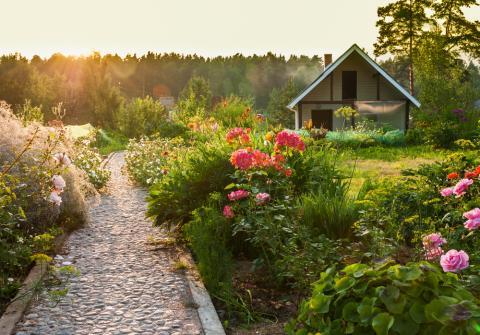
Bats—the world’s only flying mammals—are, indeed, amazing flyers and give birds a run for their money. In Arizona, New Mexico, Texas, and Florida, bats are also important native pollinators. Those majestic Saguaro and Organ Pipe cacti you see in southern Arizona and Northern Mexico….they’re pollinated by bats. As is agave, the plant from which tequila and mezcal are derived. Bats also pollinate almond and peach trees. Indeed, bats are found throughout North America.
If you’re a bat-o-phile like me, you can attract them to your garden. There are a whole bunch of beautiful flowers you can plant that bats like. And, you can even put up a bat house! These are commercially available and have a different shape than typical birdhouses in order to suit the particular needs of bats. Hang your bat house at least 12 feet up on a south facing corner of your house or on a pole. Even better if there’s water nearby. Don’t hang your bat house in a tree, where predators can easily get to them and branches may shade the house. Bats like a warm house.
Bats go for large white or light-colored flowers that are highly fragrant. And who wouldn’t want such flowers in their garden? Bats are handy to have around, even if they give you the heebie-jeebies…they can eat hundreds of mosquitos an hour, and they eat many other pests as well. Bats also spread seeds.
Here are 5 easy plants to grow for your bat garden!
Four O’Clocks
Four o’clocks (Mirabilis species) are native to North and South America. Their name reflects the fact that they bloom in late afternoon. Mirabilis jalapa, native to Peru, is a popular garden ornamental that grows as a perennial in USDA hardiness zones 9-11. Elsewhere, they can be grown as annuals. A more cold-tolerant species is native to Colorado where I am, named (originally enough) the Colorado Four O’Clock (Mirabilis multiflora). This one can handle USDA hardiness zone 5.
These colorful and fragrant flowers are easy to grow either from seeds or root division. Depending on where you live, they will reseed and spread the next summer, so if you don’t want a lawn of four o’clocks, you might want to plant them in containers. They’re not too picky about soil and they’re drought tolerant to boot!
Some Mirabilis species have toxic alkaloids, so you may want to skip this one if you have pets or children who like to chew on your garden plants.
Honeysuckle
Honeysuckles (Lonicera species) are another fragrant and easy-to-grow plant that bats love. I like the vine-y forms of honeysuckle for growing on a fence or trellis, but there are shrubby species as well.
Japanese honeysuckle is common in garden shops and is one of the more familiar species. The flowers are a lovely, cooling remedy for hot, irritated respiratory tract issues.
Datura
These gorgeous, white flowers are another easy addition to the garden. There are also varieties of Datura (Datura species) with red, purple, or yellow flowers. The fragrant flowers are even more strongly scented at night. Daturas are perennial in USDA hardiness zones 8-10 and annuals in zones 5-7. These will grow quickly from seed planted either inside or outside, as long as they get a lot of sun, well-drained soil and regular watering. Full sun will also promote more blooms.
Datura flower essences are available commercially and are used for shifting one’s perspective of reality, for feelings of isolation or disassociation, and to encourage a more expansive view.
Evening Primrose
Yellow evening primrose (Oenothera biennis and others) continues the trend of easy-to-grow plants. It likes sunny, open areas on the dry side and will reseed. Evening primrose is used medicinally for issues ranging from anxiety to menopausal issues to endometriosis. Besides that, they will smell wonderful at night, while luring in some bat friends. Evening primrose is drought tolerant but does like regular watering.
Moon Flowers
These big, glowing white beauties are related to passionflower. Moon flower (Ipomoea alba) is a vine with lovely, heart-shaped leaves, and will be perennial in warmer areas (zones 10 and 11) but can still be cultivated as a fast-growing annual in colder areas. The flowers open and release their scent at night and close in the morning. This is another toxic species, something to consider depending on who’s hanging out in your garden.
Happy planting and enjoy your new flying friends!








